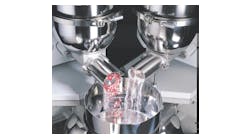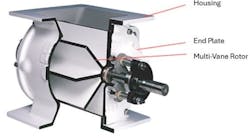Electrostatic discharge hazards, arising from the generation and accumulation of static electricity, pose a serious threat to industrial environments that handle bulk solids. From grain silos to powder processing plants, the potential for disastrous consequences demands attention and preventive measures. This article explores the causes and effects of electrostatic hazards and discusses methods to effectively control and mitigate them.
Electrostatic charge generation
Static electricity can play a significant role in the occurrence of flash fire and explosion hazards within bulk solids processes. To understand the origins of these hazards, it is important to first explore the fundamental principles of static electricity and its creation.
Static electricity arises from the imbalanced distribution of electrical charges on the surface of an object or material. In bulk solids processes, the generation of static charges primarily stems from frictional contact between particles and process plant, mutual (fluidized) contact between particles, and, in both cases, their separation.
Frictional contact. Frictional contact between two surfaces is a common source of static charge generation. When particles come into contact/rub against the walls of processing equipment, electrons can transfer from one surface to another, resulting in a charge imbalance. This is particularly prevalent in situations involving dry, granular materials such as powders or grains.
Mutual (fluidized) contact. Mutual (fluidized) contact, where solid particles are suspended and transported by a gas, can also induce static charge accumulation. As particles move through a fluidized bed or a pneumatic conveying system, for example, the frictional contact between the particles can cause charge generation in addition to the charge generation occurring from frictional contact between the particles and plant.
Separation. After contact, when two different or similar materials separate or are pulled apart, they can be left with opposite charges. For example, during the loading or unloading of bulk solid materials, such as in pneumatic conveyors or through chutes, the particles can become charged due to contact and separation with the conveying equipment and each other.
Various factors influence the degree of charge generation and charge accumulation, including the material's electrical properties, particle size and shape, humidity levels, temperature, contact pressure, type of contact (point or sliding) and the presence of additives or contaminants. For instance, while most materials will charge to some degree as a result of contact, materials that are electrically insulating are more likely to retain static charges over time.
Hazards of electrostatic discharge
In bulk solids processes, when static charge levels reach their “tipping point,” they unleash discharge(s), possibly with devastating consequences. The potential hazards associated with electrostatic discharge in industrial environments include the following:
Ignition of explosible dust clouds. One of the most dangerous consequences of uncontrolled electrostatic discharge is the ignition of explosible dust clouds. Many bulk solid materials, such as grain, flour, coal, and many chemicals, possess the ability to form explosible dust clouds when dispersed in air. An electrostatic discharge occurring within these clouds can act as an ignition source, leading to catastrophic explosions and fires. Several tragic industrial incidents, including grain silos and powder processing plants of various types, have been attributed to the ignition of dust clouds by electrostatic sparks.
Equipment damage and malfunction. Electrostatic discharge can also wreak havoc on sensitive electronic equipment. The discharge of static electricity can induce voltage surges or electromagnetic interference, causing malfunctions, data loss, or even permanent damage to electronic components.
Personnel safety risks. In addition to the potential harm caused by dust explosions and equipment damage, electrostatic discharge can sometimes pose direct risks to personnel working in bulk solids processes. A discharge to an individual can result in electric shock, which can cause burns, muscle contractions, and even heart-related injuries. The severity of the shock depends on factors such as the magnitude of the discharge and the path the current takes through the body. Most static discharges to people are harmless, but on rare occasions, the consequences can be severe.
Flammable gas/vapors. Electrostatic discharges can also have severe consequences when they occur in processes involving flammable gases and vapors. As with dust explosions, discharges resulting from the generation and accumulation of static charge on process plant can result in flashfires or explosions, with consequential risk to operators, the business, and the environment. In general, flammable gas and vapor atmospheres are easier to ignite than dust clouds because of their lower minimum ignition energy (MIE) by one or two orders of magnitude.
By understanding the consequences of electrostatic discharge, industries can prioritize the implementation of robust control strategies to ensure the safety of both people and processes.
Minimizing the risk of electrostatic discharge
Researchers and scientists have conducted numerous experiments to better understand the generation of static electricity within bulk solids processes. These experiments have involved measuring charge potentials and studying the impact of different factors, including environmental conditions, both in the laboratory and on full-scale equipment. Better understanding of how static charges originate has allowed researchers and engineers to develop effective control strategies to mitigate electrostatic hazards. These control measures include grounding and bonding, ionizers and antistatic additives, and process study and modifications as well as training and education.
Grounding and bonding. Grounding and bonding of conductive process plant and equipment provides a direct path for static charges to dissipate harmlessly. Grounding involves connecting conductive components or equipment to earth through a designated grounding point, effectively neutralizing any accumulated charges. Bonding, on the other hand, involves connecting conductive materials together to equalize their potentials.
The grounding of personnel is sometimes also an important step to take where operators are working in the vicinity of explosible dusts with MIEs less than 30 mJ or flammable gas and vapor atmospheres. This can often be accomplished using static dissipative footwear, but this is only effective where the working floors are also static dissipative.
By implementing proper bonding and grounding systems throughout the bulk solids process, the risk of hazardous electrostatic discharges can be significantly reduced but not always eliminated.
Ionizers and antistatic additives. Ionizers are devices that emit ions to neutralize static charges on surfaces in the surrounding areas. They can be strategically placed in areas where charge accumulation is likely to occur, such as near conveyor belts and chutes or in storage bins. Ionizers help to maintain a balanced charge distribution, minimizing the potential for discharges. Additionally, antistatic additives can sometimes be incorporated into process materials to enhance their conductivity and dissipate static charges more effectively.
Process study and modifications. In some cases, modifying the bulk solids process itself can be an effective approach to controlling electrostatic hazards. This may involve adjusting parameters such as airflow velocity and humidity levels to minimize charge generation and accumulation. For example, maintaining proper moisture content in certain materials can increase their conductivity and reduce the likelihood of static charge buildup.
Additionally, optimizing the design of equipment and facilities to minimize friction and promote grounding can significantly mitigate electrostatic risks. Sometimes it is possible to study plant charging situations with the aid of laboratory tests to find where in a process charging is taking place — the first step before mitigation. Sometimes the introduction of a “wait time” in a process, to allow accumulated charge to conduct safely away to ground, can offer a solution to static problems.
Training and education. No control strategy is complete without proper training and education. Personnel involved in bulk solids processes should be educated about the risks associated with electrostatic hazards and trained to identify and report static electricity. This includes understanding the principles of static electricity, recognizing potential sources of charge generation and accumulation, and knowing how to safely handle materials and equipment in electrostatic-sensitive environments. By raising awareness and providing training, industries can empower their workforce to recognize the early warning signs1 and help identify static problems so they can be assessed and addressed by qualified persons.
Control measures should be tailored to the specific characteristics of each bulk solids process. Conducting thorough risk assessments, involving experts, and adhering to industry standards and guidelines such as NFPA 772 are essential to developing an effective electrostatic hazard control program.
By implementing a comprehensive approach that combines these measures, industries can successfully control electrostatic hazards. This not only helps to ensure the safety of personnel but also promotes efficient and uninterrupted bulk solids processing.
Spreading awareness and best practices
For controlling electrostatic hazards in bulk solids processes, knowledge is power, and awareness is the key to prevention. The importance of spreading awareness, promoting best practices, and fostering a culture of safety cannot be overstated.
Industry standards and regulations. To ensure consistent safety practices and mitigate electrostatic hazards, various industry standards and regulations have been established. Organizations such as the National Fire Protection Association (NFPA), Occupational Safety and Health Administration (OSHA), and International Electrotechnical Commission (IEC) have developed guidelines and codes specific to hazardous areas, dust explosion prevention, and control measures for static electricity2, 3. Adhering to these standards is crucial for creating a safe working environment and complying with legal requirements.
Sharing success stories and lessons learned. Case studies and industry reports detailing the causes, consequences, and prevention strategies of electrostatic hazards provide valuable insights for organizations to enhance their own safety protocols. This is one reason why Stonehouse Process Safety issues blog articles on static electricity4.
Technical papers. Continued research and development in the field of electrostatic hazard control are essential for advancing safety measures. See, for example, the authors’ recently published paper, “Static Electricity: The Early Warning Signs1.”
Training and education. Training courses on the control of static electricity in the workplace are available for organizations, groups, or individuals5.
Focused electrostatic hazard assessments. A focused electrostatic hazard assessment of processing facilities, including onsite electrostatic measurements, performed by a specialist electrostatic hazards consultant can identify hazards and provide practical control measures.
Controlling electrostatic hazards in bulk solids processes requires a multi-faceted approach that involves industry standards, sharing success stories, on-site and laboratory measurements and testing, collaboration, training, and continuous improvement. Promoting and spreading electrostatic hazards awareness can create safer working environments, protect personnel and equipment, and prevent catastrophic incidents. With a collective effort to raise awareness and implement best practices, the hazards of static electricity can be effectively controlled, ensuring safety and the continuity and productivity of bulk solids processes.
References
- Static Electricity: The Early Warning Signs, Process Safety Progress, 2023.
- NFPA 77, 2024 edition, Recommended Practice on Static Electricity.
- IEC TS 60079-32-1:2013 Explosive Atmospheres — Part 32-1: Electrostatic hazards, Guidance.
- Process Safety Dispatch, https://stonehousesafety.com/blog/
- stonehousesafety.com/training-courses
Paul Cartwright, BSc, DPhil, C.Phys. is chairman and co-founder of Stonehouse Process Safety Inc. Paul has worked in the process industries for more than 30 years, largely in the field of process safety. Earlier in his career, Paul co-founded and served as CEO of Chilworth Technology, a leading global provider of process safety consulting, training, and testing services. Paul began his career as a safety engineer with a major UK-based oil company and has conducted university research on electrostatics and dust explosions and has published many papers and articles on his work.
Vahid Ebadat Ph.D., M.Inst.P, MIET, C.Phys. is CEO and co-founder of Stonehouse Process Safety, Inc. Vahid has worked extensively as a process safety consultant for the chemical, pharmaceutical, food, paper/wood, and other process industries globally for over 30 years. Vahid has published many technical articles and papers and is a regular speaker on process safety topics, including dust explosion, static electricity, gas & vapor flammability, and thermal decomposition/self-heating hazard assessment and control. Vahid is a member of NFPA 77, NFPA 91, NFPA 654, and NFPA 655 Technical Committees. For more information, call 609-455-0001 or email [email protected].
Stonehouse Process Safety


